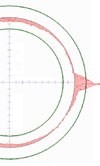Fatigue and wear in a journal bearing
 FATIGUE AND WEAR IN A JOURNAL BEARING (during start-up and boundary lubrication)
FATIGUE AND WEAR IN A JOURNAL BEARING (during start-up and boundary lubrication)
When two bodies are pressed together contact stresses occur. The results of the work done in this area are due to Hertz and are referred to as Hertzian stresses. Two special cases of hertzian stresses are: contacting spheres and contacting cylinders. An example of contacting spheres would be a single row ball bearing, with a single ball contacting the inner surface of the inner or outer race. An example of contacting cylinders would be a single roller contacting the inner surface of the inner or outer race, or a crankshaft journal contacting a journal bearing. Typical failures due to hertzian stresses are seen as cracks, pits or flaking on the surface of the material.
When two surfaces roll or ‘roll and slide’ in contact with one another with sufficient force, maximum stress is developed beneath the contacting surface. A sub-surface crack appears which is initiated by this maximum stress. The crack then propagates to the surface during operation. The lubricant under pressure, enters this crack and then assists in the formation of surface pitting. This pitting constitutes a fatigue (fatigue is defined as slow crack growth) type failure and would be expected to occur in the journal bearing.
Hence, knowing the surface fatigue strength of contacting materials is quite important in order to resist this pitting type fatigue failure and is obtained by testing. The test results are made available in the form of a load stress factor or a wear factor. Hence the surface fatigue strength may be defined as the number of cycles at which the first tangible evidence of fatigue (pitting of the surface) is observed. Such failures are often called wear because they occur over a long period of time. This type of wear is not to be confused with abrasive type wear. Wear, which is normally divided into two types, namely adhesive wear and abrasive wear, is generally undesirable because it could lead to increased tolerances and possibly catastrophic failure.
Adhesive wear is associated with the adhesion between atoms of the asperities of the two contacting materials where, generally, wear fragments will be removed from the softer material asperities. Asperities (surface roughness) are like peaks of a mountain range which are present on the journal and journal bearing surfaces. If work hardening extends into the asperity, the size of the fragment sheared off will be larger. In order to minimise the size of the wear fragment either decrease the loading between the journal and the bearing or increase the hardness of the journal.
Abrasive wear occurs when, for example, a hard particle digs into the softer material. These wear particles can come from the wear particles due to adhesive wear. These dislodged softer particles become oxidised (due to oxygen in the lubricant) converting them into hard oxidised particles which then rub against the surfaces and cause wear. The journal bearing wears the most and is then replaced. Note, these former asperities are not the only source of wear in an engine as the products of combustion, dirt and dust particles also contribute to journal bearing wear but such abrasive wear can be reduced through good filtration.
Frictional forces overcome friction and are undesirable in bearings because of the power they absorb. When two surfaces are in contact with each other, the asperities of one surface sit on top of the asperities of the other and the resultant friction is due to the sliding over (shearing) or breaking of the contacting asperities. Surfaces even when polished and ground have asperities. The load pressing the surfaces together is supported solely by the contacting asperities and as the contact area of each asperity is very small, the stress on each asperity is therefore very large. At low loads the asperities deform elastically but at high loads the asperities deform plastically and require more energy to shear them.
The work done in overcoming friction is mainly converted to heat at the sliding surfaces. In order to minimise these frictional forces, it is necessary to coat the asperities with polymers or soft metals. Many journal bearings have a thin film of soft metal on the surface of the bearing, for example, white metal. The softer metal forms a lubricating film and has a relatively low coefficient of friction, which should be low enough to prevent seizure in the case of boundary lubrication, or no lubrication at all.
Written by Eric Smart.